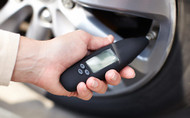Do I Need to Replace TPMS When Replacing Tires?
Posted by Agota Szabo on Dec 22nd 2020
Tire Pressure Monitoring Sensors or TPMS is a relatively new technology on the vehicle market, however, nowadays most vehicles will come with one. So, what is exactly a TPMS sensor?

Simply put, it is a built-in sensor which monitors the air pressure in the tires and notifies the vehicle’s driver of any issues. It is quite a useful tool your vehicle is equipped with, which can save you from complete tire failure.
There are two types of TPMS on the market today: direct and indirect models.
A direct TPMS sensor gives real-time readings of the tire pressure. This is the more accurate version, which constantly monitors the tires with the sensors they are operated by. The sensor transmits a radio transmission to the vehicle’s Electronic Control Unit and allows the driver to constantly follow the air pressure rate of the tires.
On the other hand, an indirect TPMS sensor does not have any sensors. They utilize the Anti-Lock Braking ring to notify the driver when the air pressure drastically changes in the tire. They give a less accurate reading than direct models as they do not provide constant monitoring. Basically, indirect models activate the light on the vehicle’s dashboard when the air pressure change is severe.
Does the TPMS Reset After a Tire Change?
The short answer is that it depends on which TPMS sensor type you have in your vehicle.
Direct TPMS sensors use an automatic readjusting system, which allows the vehicle to reset the sensor after the tires are changed. This system makes it easier, as everything is automated and the TPMS sensor does not need to be reset manually. It just takes the vehicle a few miles to work out the pressure reading and then adjust the sensors to the new pressures.

Indirect TPMS sensors are a bit trickier. In most cases, you or your mechanic will have to manually reset the system. If this step of the process is not done, the TPMS will continue to show the low-pressure warning light on the dashboard. However, this still does not mean that the TPMS needs to be replaced. It is just a question of button-handling on the dashboard to get it working again.
When does the TPMS Need to be Replaced?
TPMS systems or sensors still need regular checkups and replacements as external factors can hinder their performance. Generally speaking, the most common issues which arise are corrosion, damage and run-down battery life.
If the vehicle is not equipped with a snap-in, rubber valve stem TPMS sensor, corrosion may become a problem. The biggest culprit is the road salt used in winter weather conditions. It may accelerate the rusting of not just the TPMS sensor, but at times the vehicle as well.

By damage, we mean accidental damage which may occur during the vehicle’s regular performance. Their position on the tires makes them face higher levels of danger than most other parts of the vehicle. For this reason, vehicle accidents, potholes, and flat tires can easily damage them.
Lastly, all TPMS sensors are operated by a battery. While most sensors do not run 24/7 – in this manner, they work on a battery-saving mode. Yet, they still have a lifespan. Usually, that span is between 5 to 10 years. Once the battery runs out, depending on the vehicle's system, you might need to change the entire system or the individual sensors.
However, if you sense that the battery life of these sensors is nearing the end, it would be advisable to change them when you install new tires. It will save you on the labor cost, but you do not need to do that every time.
















